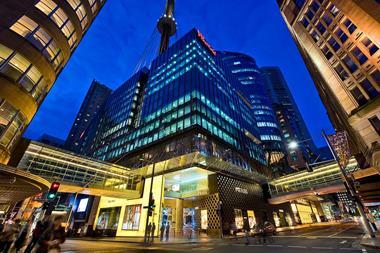UK - The UK commercial property market saw its biggest fall in value for more than a decade in 2007, according to the Investment Property Database, but experts warn there could be more to come as investors have been selling more liquid, prime real estate.
Details of the IPD's UK annual report presented last week by Malcolm Frodsham, research director at the IPD, reveal West End offices was the only segment of the UK market said to generate a positive return in 2007, as there were strong gains seen in the first half of the year, before all sectors of the real estate market were hit by negative sentiment in the second half and the year-end the total benchmark return hit-7.6%.
The property market was worst hit in the fourth quarter, as valuations led to the market delivering a -4.4% negative return in the last three months of the year. Worst hit was the retail market, which saw a -8.2% loss in Q4, followed by -8% in offices and -6.3% in industrials.
Over the 12 months to December 31, 2007, the retail sector's performance fell 7.1%, while offices closed down -1.2% - helped by that surge in the early months - while industrials generated a negative benchmark return of -3.9%.
Income yields were still positive - the retail, office and industrial markets generating - 4.4%, 4.6% and 5.3% respectively - but the downturn was the result of capital losses on property valuations so "the falling capital valuations are going to put some upward pressure on initial yields", said Frodsham.
"Strategy is going to be dominated by time, and when investors are going to put money back into the market. What investors have been doing is selling their low-yielding assets, so they yield in Q3 is felt through more liquid stocks in retail and offices. That is important because it sets the evidence for the valuers, so we have not unwound the yield compression yet because [investors] have not been selling their [secondary] stock. The hope in the market is we have hit the market price but time will tell and if the market takes pricing with it we could see the second phase. The risk doubles if the occupier market goes with the economy," added Frodsham.
Warehouses struggled much more than in other retail sectors as has been the case since Q4 2005, according to figures presented by Frodsham, but Birmingham was the best performer with a benchmark loss of just -0.3% compared with -11.3% in Liverpool.
In the office market, Scotland fared best - outside the inclusion of West End London - by losing just 3.2% while the West Midlands had a benchmark loss of 7.2%. That said, smaller office centres appear to have performed better than larger centres, according to IPD.
Ian Cullen, head of systems and information standards at the IPD, warned it was unclear how the UK commercial market would perform over the coming months but suggests the major drop in value is perhaps being visibly driven much more by investor confidence than in past experience.
"This is one of the biggest and quickest falls on the records we have. We have never seen single quarter down movements at this pace. That is not to say in the mid-70s there was no single quarter downturn. It was purely yield-driven [market] which was moving positively towards the end of [this] year, so [the loss] was exclusively driven by a collapse in investor confidence pushing yields through a mistrusted transaction evidence," said Cullen.
He continued: The complexities is where that collapse in confidence comes from is a much bigger picture than property. But we don't know in practice the way in which this financial crisis will move and whether it is going to be a ‘one stage' or a ‘two stage' recession. Clearly we have seen one stage as we have seen unprecedented falls. Whether that will translate into consumer confidence or employment confidence will be determined only after 12 months, with the possibility of an early recovery in the second half [of the year] or whether this is a three-year recession - we don't know.
Over 200 property portfolios worth £120bn (€160bn) are included in the IPD study - although properties held by Land Securities were not included in the assessment - but this is down from £135bn in 2006.
Most interestingly, officials now recognise market sentiment is now an important element of property valuations, and should be considered so, according to Robert Peto, chairman of DTZ UK, who was part of a guest panel at the launch of the IPD annual report.
"The issue of valuing towards sentiment is an acceptability issue, that is what a valuer has to do. We have some evidence but valuers are paid to put their head on the block sentiment affects the market. That is a big change and I hope it remains like that going forward. The change in circumstances is the make up of funds means 1/3 of the monthly index is made up of retail-type funds - three times what is was in the last cycle, which poses some interesting challenges to the valuer industry. There is realisation of what market valuation actually means. All valuations have to be looked at through the eyes of the purchasers, not the vendors, that is the reality," said Peto.
Market commentators have been arguing for some time it was difficult to know what property valuations should be, because there was a dearth of evidence to support valuations, and the industry was relying on the ability of valuers to make valuations based on "what they feel" or "where the market should be". (See earlier IPE Real Estate story: Valuations lack supporting evidence - Segro)
The IPD last conducted a valuations study three years ago, to try and ascertain how data is used and gathered by valuers, and the body has plans to conduct a fresh study in a few months' time, according to Cullen, which is in part a discursive of the valuers, to find out what evidence they themselves use.
"If a collapse in investor confidence is a sentiment thing, [valuers] have to be working on an emotional basis. But there is evidence around, albeit it is clearly thinner than other phases of the market. They have to find the best possible estimate with the evidence in the market," he added.












